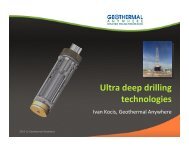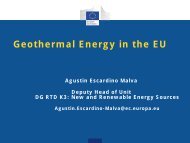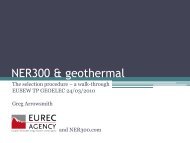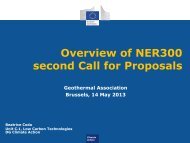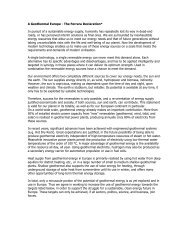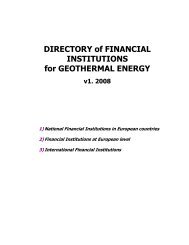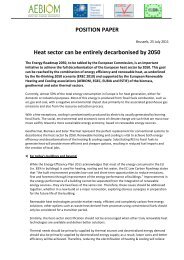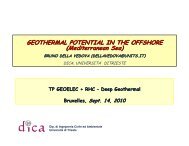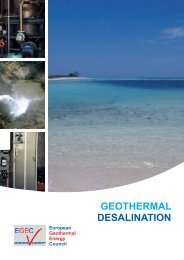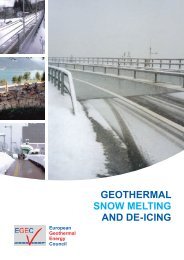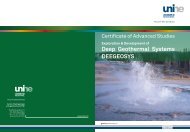Strategic Research and Innovation Agenda for Renewable ... - EGEC
Strategic Research and Innovation Agenda for Renewable ... - EGEC
Strategic Research and Innovation Agenda for Renewable ... - EGEC
You also want an ePaper? Increase the reach of your titles
YUMPU automatically turns print PDFs into web optimized ePapers that Google loves.
<strong>Renewable</strong>Heating & CoolingEuropean Technology Plat<strong>for</strong>mCCT.21ObjectiveOptimised integration of renewable energy sources in DHC systems <strong>and</strong> enhancementof thermal energy storage at system levelFurther research activities are needed to allow DHC networks to efficiently integrate all types ofRES without jeopardising the quality of the service provided to the consumers. In the same way,it is important to explore new synergies between various customer groups with different thermalneeds. The DHC sector must be able to recycle <strong>and</strong> upgrade all available surplus energy, as wellas any surplus industrial heat.Energy storage is a central component <strong>for</strong> the introduction of more flexible district <strong>and</strong> heatingsystems, using variable energy sources with a fluctuating thermal dem<strong>and</strong>. Storage solutionsalready exist <strong>for</strong> district heating systems but they mainly suit short term storage. There is a needto develop flexible, efficient, multifunctional <strong>and</strong> cost-effective thermal storage.State-of-the artCurrently DHC networks are mainly based upon few individual heat/cold sources, operatedproportional to the heat/cold dem<strong>and</strong> of the network. For integration of variable supply fromrenewable or industrial surplus sources, the system structure <strong>and</strong> operational strategy mustbe changed radically.Today’s systems <strong>for</strong> short-term <strong>and</strong> seasonal storage use tanks with constant volume.In seasonal storage, especially when two tanks are used (cold <strong>and</strong> hot tank, or charged<strong>and</strong> discharged tank), twice the volume is required.TargetsType of activity• This activity should result in a 30% reduction of heat costs from industrial surplus heat,<strong>and</strong> 10% reduction of primary energy use.• Demonstrate in at least 5 projects innovative DHC concepts combining multiple RES<strong>and</strong> different dem<strong>and</strong> profiles.• Reducing energy consumption by 10% by using <strong>and</strong> optimising distributed energy storagesolutions.• Seasonal cold storage: reach the same efficiency as seasonal heat storage.• For flexible volume tanks: 70% volume occupancy by 2030.• New thermal carrier: 10% more efficient in terms of thermal storage than water.30% <strong>Research</strong> / 40% Development / 30% Demonstration<strong>Research</strong> <strong>and</strong> <strong>Innovation</strong> Priorities Predominant type of activity ImpactCCT.17 Large scale demonstration of Smart Thermal Grids Demonstration By 2020CCT.18 Booster Heat Pump <strong>for</strong> DHC Demonstration By 2020CCT.19CCT.20CCT.21Develop <strong>and</strong> roll-out DHC driven white goods <strong>and</strong> lowtemperature solution <strong>for</strong> domestic hot water preparationImproved, highly efficient substations <strong>for</strong> both present<strong>and</strong> future lower temperature networksOptimised integration of renewable energy sourcesin DHC systems <strong>and</strong> enhancement of thermal energystorage at system levelDevelopment / Demonstration By 2020Development By 2030Demonstration By 2030Table 18: research <strong>and</strong> innovation priorities <strong>for</strong> DHC technology enabling a higherpenetration of RES71



